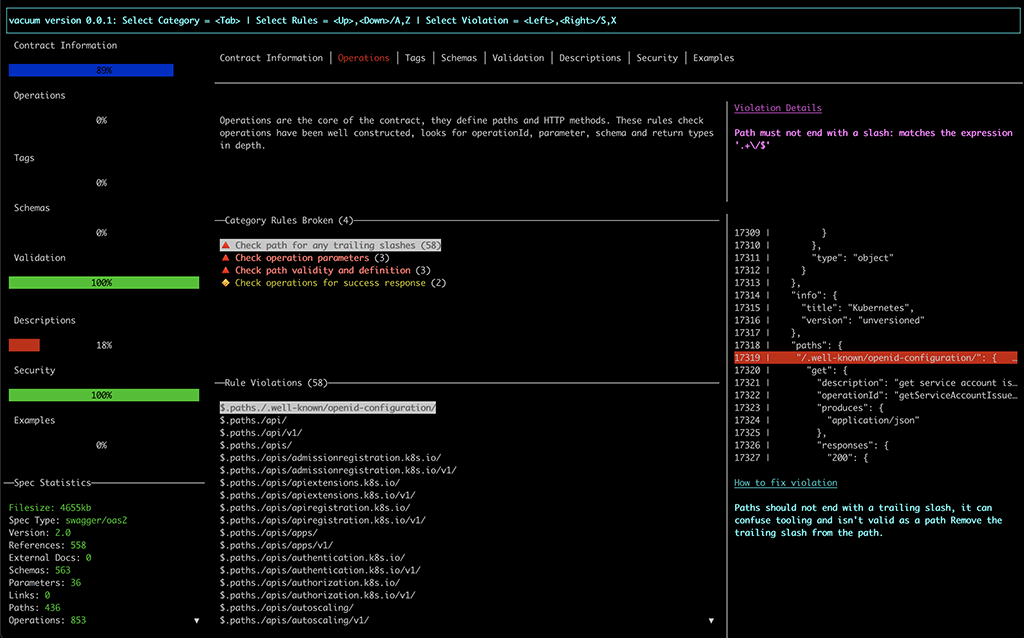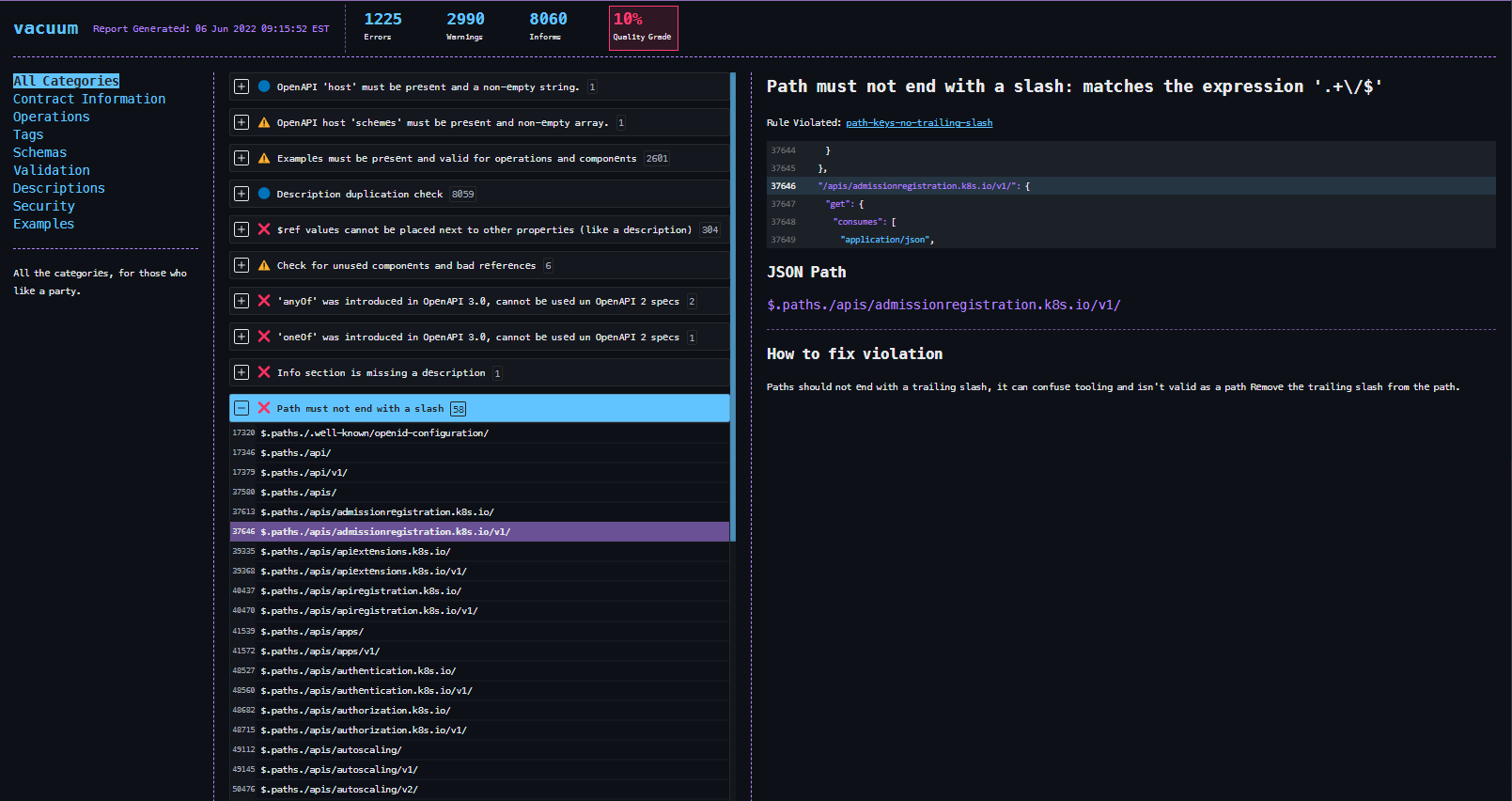An ultra-super-fast, lightweight OpenAPI linter and quality checking tool, written in golang and inspired by Spectral.
It's also compatible with existing Spectral rulesets.
Install using homebrew tap
brew install daveshanley/vacuum/vacuum
Install using npm
npm i -g @quobix/vacuum
Install using yarn
yarn global add @quobix/vacuum
Install using curl
curl -fsSL https://quobix.com/scripts/install_vacuum.sh | sh
Sponsors
If your company is using vacuum, please considering supporting this project,
like our very kind sponsors:
Documentation
Quick Start Guide 🚀
See all the documentation at https://quobix.com/vacuum
- Installing vacuum
- About vacuum
- Why should you care?
- Concepts
- CLI Commands
- Developer API
- Rules
- Functions
- Understanding RuleSets
vacuum can suck all the lint of a 5mb OpenAPI spec in about 230ms.
Designed to reliably lint OpenAPI specifications, very, very quickly. Including very large ones. Spectral can be quite slow when used as an API and does not scale for enterprise applications.
vacuum will tell you what is wrong with your spec, why, where and how to fix it.
vacuum will work at scale and is designed as a CLI (with a web or console UI) and a library to be consumed in other applications.
Dashboard
vacuum comes with an interactive dashboard (vacuum dashboard <your-openapi-spec.yaml>) allowing you to explore
rules and violations in a console, without having to scroll through thousands of results.
HTML Report
vacuum can generate an easy to navigate and understand HTML report. Like the dashboard you can explore broken rules and violations, but in your browser.
No external dependencies, the HTML report will run completely offline.
Supports OpenAPI Version 2 (Swagger) and Version 3+
You can use either YAML or JSON, vacuum supports both formats.
AsyncAPI support is coming soon!
Check out the code
git clone https://github.com/daveshanley/vacuum.git
Change directory into vacuum
cd vacuum
Build the code
go build vacuum.go
Run the code
./vacuum lint <your-openapi-spec.yaml>
Running vacuum via Docker
vacuum is available as a container, you can pull the image from Docker Hub
docker pull dshanley/vacuum
To run, mount the current working dir to the container and use a relative path to your spec, like so
docker run --rm -v $PWD:/work:ro dshanley/vacuum lint <your-openapi-spec.yaml>
Alternatively, you can pull it from
Github packages.
To do that, replace dshanley/vacuum with ghcr.io/daveshanley/vacuum in the above commands.
Using vacuum with pre-commit
Vacuum can be used with pre-commit.
To do that, add to your .pre-commit-config.yaml:
repos:
- repo: https://github.com/daveshanley/vacuum
rev: # a tag or a commit hash from this repo, see https://github.com/daveshanley/vacuum/releases
hooks:
- id: vacuumSee the hook definition here for details on what options the hook uses and what files it checks by default.
If no filenames or more than one filename in your repository matches the default files pattern in the hook definition,
the pattern needs to be overridden in your config so that it matches exactly one filename to lint at a time.
To lint multiple files, specify the hook multiple times with the appropriate overrides.
Build an interactive HTML report
./vacuum html-report <your-openapi-spec.yaml | vacuum-report.json.gz> <report-name.html>
You can replace report-name.html with your own choice of filename. Open the report
in your favorite browser and explore the results.
See full linting report
./vacuum lint -d <your-openapi-spec.yaml>
See full linting report with inline code snippets
./vacuum lint -d -s <your-openapi-spec.yaml>
See just the linting errors
./vacuum lint -d -e <your-openapi-spec.yaml>
See just a specific category of report
./vacuum lint -d -c schemas <your-openapi-spec.yaml>
The options here are:
examplesoperationsinformationdescriptionsschemassecuritytagsvalidation
Generate a Spectral compatible report
If you're already using Spectral JSON reports, and you want to use vacuum instead, use the spectral-report command
./vacuum spectral-report <your-openapi-spec.yaml> <report-output-name.json>
The report file name is optional. The default report output name is vacuum-spectral-report.json
Generate a vacuum report
Vacuum reports are complete snapshots in time of a linting report for a specification. These reports can be 'replayed'
back through vacuum. Use the dashboard or the html-report commands to 'replay' the report and explore the results
as they were when the report was generated.
./vacuum report -c <your-openapi-spec.yaml> <report-prefix>
The default name of the report will be vacuum-report-MM-DD-YY-HH_MM_SS.json. You can change the prefix by supplying
it as the second argument to the report command.
Ideally, you should compress the report using -c. This shrinks down the size significantly. vacuum automatically
recognizes a compressed report file and will deal with it automatically when reading.
When using compression, the file name will be
vacuum-report-MM-DD-YY-HH_MM_SS.json.gz. vacuum uses gzip internally.
Try out the dashboard
This is an early, but working console UI for vacuum. The code isn't great, it needs a lot of clean up, but if you're interested in seeing how things are progressing, it's available.
./vacuum dashboard <your-openapi-spec.yaml | vacuum-report.json.gz>
Supply your own Spectral ruleset
If you're already using Spectral and you have your own custom ruleset, then you can use it with Vacuum!
The lint, dashboard and spectral-report commands all accept a -r or --ruleset flag, defining the path to your ruleset file.
Here are some examples you can try
All rules turned off
./vacuum lint -r rulesets/examples/norules-ruleset.yaml <your-openapi-spec.yaml>
Only recommended rules
./vacuum lint -r rulesets/examples/recommended-ruleset.yaml <your-openapi-spec.yaml>
Enable specific rules only
./vacuum lint -r rulesets/examples/specific-ruleset.yaml <your-openapi-spec.yaml>
Custom rules
./vacuum lint -r rulesets/examples/custom-ruleset.yaml <your-openapi-spec.yaml>
_All rules, all of them!
./vacuum lint -r rulesets/examples/all-ruleset.yaml <your-openapi-spec.yaml>
Let me know what you think.
Logo gopher is modified, originally from egonelbre



